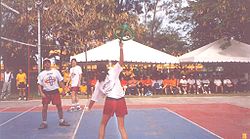- Doonee
-
Doonee (or Duni) is a sport in which the goal is to exchange a special ball, called a COR, in a rectangular court, divided by two parallel nets. The ball can only be touched by hand and, its weight varies depending on the players category. The main purpose of Doonee is to promote and support non-violent behavior. Doonee's main feature lies in its five fundamental laws:
Contents
Fundamental laws
- The COR is never stroked, punched, kicked, etc. (Universal Law of NON-VIOLENCE).
- The COR is never stopped. (Universal Law of PERPETUAL MOVEMENT).
- The COR keeps the same speed during the match. (Universal Law of CONSERVATION OF ENERGY).
- The COR can only be thrown describing curved lines. (Universal Law of CURVE OF LIFE).
- The COR can neither be slowed down, nor stopped. (Universal Law of NO-RESISTANCE).
The Ball (COR)
The two main aspects of the Doonee's BALL are:
- It's a HOLLOW ball.
- It's a BALL which weight ranges from some grams to several kilograms, depending on the category of the Doonee players in a match.
History
Doonee was born as a sport during 1973 in Argentina, and is the final result of an in-depth analysis and study of more than 200 sports, made by its own creator. So far Doonee is played in several countries such as; USA, Mexico, Chile and Spain, and is still spreading world wide.
The original name in Spanish, "duni", is the acromym of the words "Deporte UNIversal" (Universal Sport). The English name, "doonee", is a phonetic adaptation of "duni".
Mission
Doonee's mission is mainly to claim for itself the title of "Non-violent Sport".
Benefits
The benefits of playing Doonee are among others:
- Physical training by exercising legs, arms and back.
- Improvements in the body balance.
- Improvements in the speed of the reflexes response.
- Increase of concentration.
External links
Categories:- Team sports
- Ball games
- Sport in Argentina
Wikimedia Foundation. 2010.

